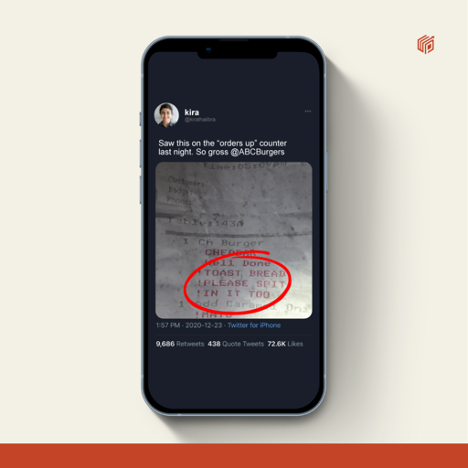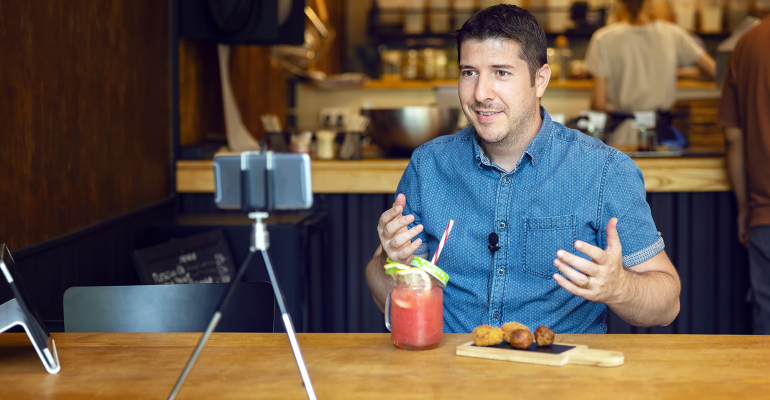User generated content (UGC) is everywhere. In a nutshell, UGC is anything a user posts or shares, such as photos, comments or reviews. UGC is essential to the modern restaurant’s growth. Positive reviews can attract new customers and drive traffic to a restaurant just as a user’s video testimonial from a recent positive dining experience can influence others to go check it out. Restaurants use UGC as an effective branding tool, filling their own social media feeds and running ads with this organic content. Not only does it come across as more authentic, but UGC is also a cost-effective way to capture and share real sentiments.
Beyond social media and reviews, restaurants are driving revenue through delivery apps, specialty promotions and their own proprietary apps and webpages, all of which hold space for UGC in one way or another.
As great as it is when used properly, UGC is not without risks. Users are unpredictable and one bad apple can ruin the bunch. There are specific vulnerabilities in the food and beverage industry that operators should be aware of in order to maintain brand reputation and avoid facing legal consequences.
Brand reputation risks
The best restaurants understand the specific content to look out for when it comes to UGC so that their brand is not damaged. There are some common types we see over and over in the food and beverage industry. Both positive and negative comments are necessary for a restaurant to be seen as trustworthy, but brand trashing, mentions of competing brands and controversial content can and should be filtered out. Brand trashing is more intentionally hostile, sometimes posted by users or competitors who have a personal vendetta against the restaurant.
 Differentiating one’s restaurant brand from the competition is essential to survival, so restaurants should remove feedback mentioning or including photos from competing brands on their own channels. It may not even be intentional; sometimes a user mistakes one restaurant for another, posting a review or a photo to the wrong place. These should be addressed and removed to avoid confusion.
Differentiating one’s restaurant brand from the competition is essential to survival, so restaurants should remove feedback mentioning or including photos from competing brands on their own channels. It may not even be intentional; sometimes a user mistakes one restaurant for another, posting a review or a photo to the wrong place. These should be addressed and removed to avoid confusion.
As far as controversial content goes, UGC depicting overconsumption of alcohol, or content suggesting alcohol leads to sexual success, is also problematic, no matter how entertaining content creators think it is. UGC featuring overconsumption of food or obesity can undermine a brand’s efforts, especially in quick serve or fast-casual restaurants. What is deemed as controversial content may be determined by the restaurant itself, for instance, a steakhouse and a vegan restaurant will have totally different ideas of what is acceptable.
Food delivery apps
Restaurants should feel empowered to inquire into the content moderation strategies used by their delivery platform partners as these often rely on UGC, both on the diner’s side and the delivery person’s. For example, drivers can now snap a photo of the food when it’s reached the final destination. However, that photo opportunity can be abused and offend a customer, potentially costing the restaurant business. Recently, one of our employees was surprised to see the photo that was shared had captured them grabbing their dinner in a robe. To avoid this vulnerability, restaurants should ask to see what measures delivery apps are implementing to avoid harmful UGC.
Anyone familiar with restaurants knows the comment section on orders, meant to allow for personalization, can go awry. Users can input messages when they order food via app for pickup or delivery just as restaurant employees can add notes to an order. In one stunning incident, a customer spotted and took a photo of a restaurant ticket with a special request to “please spit in it too.” Whether it was meant as a joke or a not, this highlights how UGC lurks in unexpected places and can be harmful to a restaurant’s overall reputation. Modifying orders can allow for personalization, but it can also open the door for misuse.
Promotions and giveaways
Competitions are an engaging way to reach a target audience. Not only do promotions generate a lot of buzz, but they also require very little time and effort. They’re worth it, so long as restaurants are aware of the potential for controversy. For instance, promotions which encourage applicants to submit a photo in order to enter can open a restaurant up to illicit or inappropriate content. When Molson ran a giveaway asking participants to share images of them enjoying the brand at parties, some of the content seemed to encourage binge drinking, putting an early end to the contest. To ensure these giveaways don’t get hijacked by a group of people sharing profane and illicit content, consistent moderation and removal of offensive material is a necessity.
Hate and harassment
This one is not specific to restaurants, but it’s a good reminder all the same. Restaurants should always be on the lookout for and remove UGC that includes cyberbullying, hate speech, harassment or abuse. With 2024 being an election year, restaurants need to be hypervigilant when avoiding hostilities.
At the end of the day, restaurants are on the hook for creating a positive customer experience not just at the table, but in the digital space as well. Content moderation of UGC ensures a large, loyal community of engaged customers remains a positive and beneficial business driver.
AUTHOR BIO
Joshua Buxbaum is founder and chief growth officer of WebPurify, the leading and longest running content moderation provider. Since cofounding the business in 2006, Buxbaum has leveraged his expertise in trust and safety to fuel WebPurify’s hands-on approach to content moderation. He works closely with professionals across numerous industries, helping them maintain a stellar brand reputation and take responsibility for keeping kids safe online.

